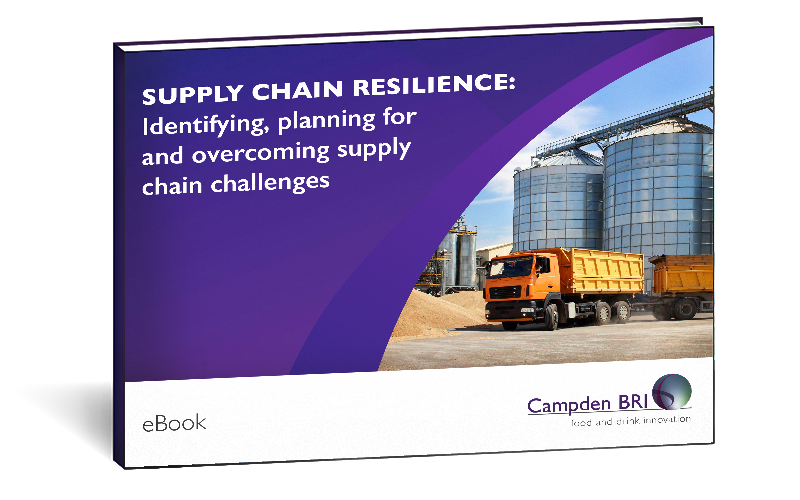
5 drivers impacting global food safety
4 December 2023
Food is kept safe by the collective efforts of all the players in the global food supply chain: national authorities by establishing relevant guidelines and standards, food producers by adopting good practices, business operators by complying with regulations and consumers by being aware of safe food handling practices. As systems evolve to respond to various challenges, food safety needs to keep pace with them.
To anticipate future concerns rather than react to them, Campden BRI has analysed emerging trends and drivers that will impact the future of food safety. To help you better prepare to tackle emerging opportunities and challenges, here are our top five.
For more on navigating potential food safety threats affecting your supply chain, download our Supply Chain Resilience eBook.
Download our FREE Supply Chain Resilience eBook today! Thrive in a changing environment by being prepared, agile and resilient.

1. Climate change
According to a recent publication from the Food and Agriculture Organization of the United Nations (FAO) , climate changes can have a direct impact on food safety hazards by altering their virulence, occurrence and distribution.
Climatic changes threaten food safety in many ways. Here are just a few:
- direct effects on pathogen growth and survival
- distribution of harmful algal blooms
- faecal contamination of crops due to increased flooding
- climate-related water scarcity and its impact on hygiene and sanitation.
2. Water use and re-use
One of the consequences of climate change is the importance and scarcity of water, alongside the increased demand brought by a growing population. This puts pressure not just on initial use but also on the re-use of water as a commodity.
Treatment / reconditioning technologies like reverse osmosis and others need to be factored into the management of water re-use, in order to reduce / eliminate hazards to a suitable level. These processes need to be validated and the water monitored.
The standard required of the water will be dependent, using a risk-based approach, on the use for which the re-used water is being applied. For example, to be fit-for-purpose as an ingredient in food, water should be potable.
Regardless of the application of the water, its sourcing, use and re-use needs to be part of your hygiene management plan. For guidance on the reuse of potable water for food processing operations, see Guideline 70.
3. Environmental considerations, including plastic packaging
The circular economy can decouple plastics from fossil fuel feedstocks and find ways to sustainably produce plastics, repurpose plastic waste and manage plastic pollution. However, a circular economy can only work if the product created using recycled materials is safe and regulatory compliant.
If the closed loop is not adequately assessed and controlled, there are potential risks for the introduction or re-introduction and concentration of food safety hazards in foods and beverages. Hazards include derivates from printing inks, coatings adhesives, secondary packaging or non-food grade polymers entering the recycling process for food-grade materials.
4. Complexities leading to food fraud and food security challenges
Food fraud has been around since ancient Greek and Roman times but is currently experiencing a rapid increase due to food shortages, the complex global supply chain and pressure on suppliers to reduce prices. Deception can take forms as diverse as the smuggling of goods across borders to avoid duties and tariffs, falsification of paperwork to misrepresent the special status of food, such as ‘organic’ or ‘kosher’, switching one species for another or adding undeclared substances to foods. While many types of food fraud do not always pose direct risks to food safety, when food is adulterated or otherwise modified, processed or (re-)packed fraudulently, the result is a product that presents significant risks to the health and well-being of consumers. The risks for consumers can include acute chemical poisoning, allergen-mediated reactions, chronic poisoning and illnesses from pathogens introduced during the adulteration process. Despite technological advancements in communication, analytics and value-chain traceability, there are currently no easy solutions for this complex problem.
5. Food consumption patterns of consumers
As consumers become more aware of the challenges facing the food system, a growing number are paying attention to how food is produced, where it comes from and whether it is good for their health and the planet. This is propelling the exploration of new food sources and different ways of producing it, such as edible insects and plant-based meat alternatives.
Traditional food and processing techniques have extensive safety data, shelf-life studies and predictive models for food protection. The same cannot be said for novel foods and new food processing methods, so it is important to determine any potential food safety risks such as the introduction of allergens into the diet, chemical hazards arising from processing or antinutrients.
Food for thought
As the transformation in the way we produce, distribute and consume food continues, there is a need for effective and proactive food safety management that keeps pace with the changing global context.
We stay abreast of the latest advancements by working not only with the entire food and drink supply chain but also by cooperating with a broad network of external partners such as academic and research institutions and national authorities.
As science evolves, we help the food and drink industry to navigate the opportunities and challenges presented by the issues outlined above. We enable the companies we work with to be resilient, agile and strategically prepared through long-term thinking.
For more on resilience, check out our ‘Supply chain resilience’ eBook.

About Andrew Collins
Andrew joined Campden BRI at the beginning of 2009. With over 30-years’ experience in a wide range of food businesses (including catering), his current role focuses on consultancy work with the holistic and practical application of food safety management including the role of HACCP and good hygiene practices.
He is a certified BowTie practitioner, and is one of the few food safety experts globally using BowTie methodology – a barrier, risk-based thinking approach to risk management in the food businesses. This approach enables businesses to build holistic, resilient and adaptive systems in a rapidly changing environment.
Andrew also works on supply chain management, agriculture and water use, animal feed and traceability. Plus, he’s part of the team that manages hygiene and allergen management.
How can we help you?
If you’d like to find out more about food safety management, contact our support team to find out how we can help.
Download our FREE ‘Supply Chain Resilience’ eBook today!
Be resilient and thrive – ensure continuity of supply of safe, quality food.







